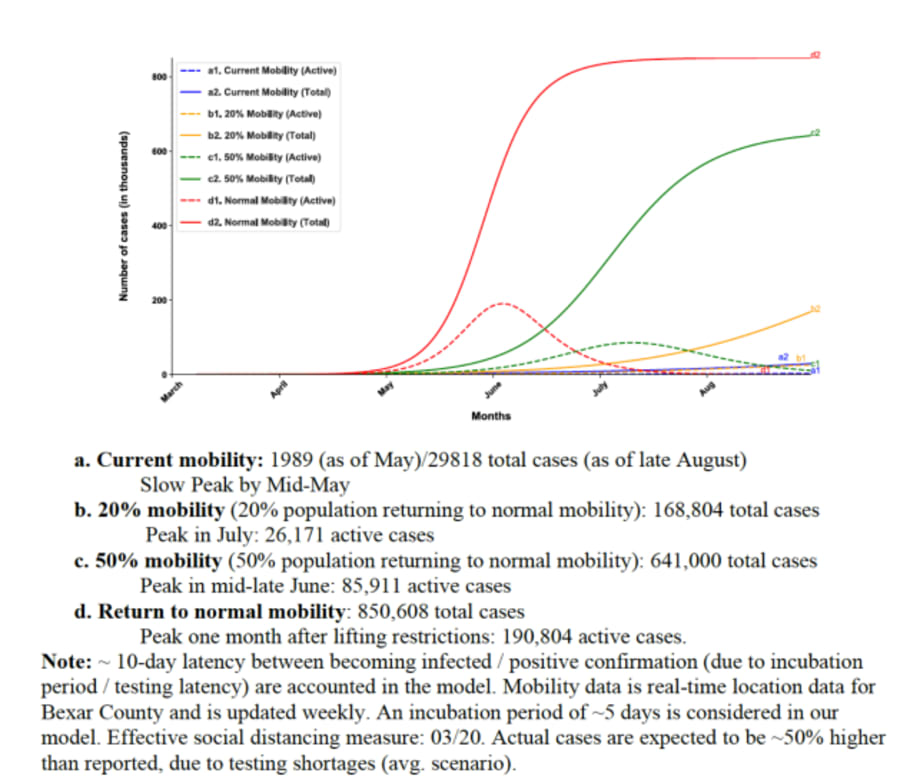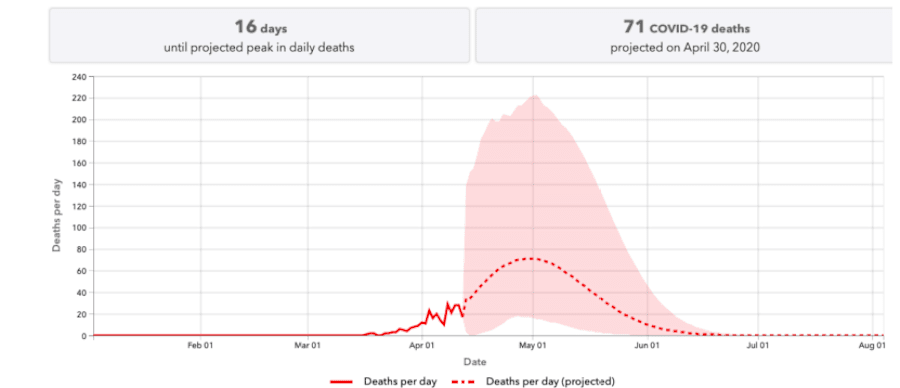SAN ANTONIO – In San Antonio, the peak of COVID-19 infections may not come until May, according to new projection models put out by the city’s Metropolitan Health District.
The city released four different models to help inform officials as they weigh how long to keep social distancing measures in place. Currently, Bexar County’s stay-at-home orders are in effect through April 30.
“The public should think of these models like they would a hurricane tracking model,” Assistant City Manager Dr. Colleen Bridger said in a news release. “They provide a range of data estimates for officials to consider along with a host of other information to make informed decisions on how to continue slowing the spread of COVID-19.”
Model 1: UTSA predictive mathematical modeling by Dr. Juan B Gutiérrez

The first model show the potential outcomes of case numbers in different scenarios:
- If no social distancing measures had been in place
- If the Stay Home, Work Safe order is lifted completely
- If high levels of social distancing continue
- If the emergency order is lifted, but “medium levels” of social distancing continue
This model anticipates 3,600 cases of COVID-19 through July if current social distancing measures remain in place. The projected peak would come by late April or early May.
With no social distancing measures in place at all, this model predicts 920,000 COVID-19 cases in the county, with a peak hitting 380,000 cases.
Model 2: UTSA AI theoretical model by Dr. Dhireesha Kudithipudi

The artificial intelligence approach is projecting a much worse scenario, even if the emergency order stays in place.
Under this model, nearly 30,000 COVID-19 cases would be reported in the county through August.
A “slow peak” would come in mid-May, according to this model, meaning the infection rate would plateau and stay flat for several days before coming back down.
“Actual cases are expected to be ~50% higher than reported, due to testing shortages,” researchers wrote as one of the footnotes in this model.
If the emergency order is lifted, this model predicts more than 850,000 COVID-19 cases in the county, with a peak one month after restrictions are lifted.
Model 3: Oliver Wyman model

Oliver Wyman, an international management consulting company, made its own model for San Antonio.
Under this model, 1,700 cases are expected to be reported through May, with a peak coming in late April.
This projection is made with social distancing measures factored in.
Model 4: University of Washington’s Institute for Health Metrics and Evaluation

This model, created by the IMHE, does not track case numbers, but resource numbers instead.
The institution created a model for each state, tracking when the peak resource usage would come and whether states will find themselves in a shortage of supplies and hospital beds.
More information on this model can be found here.
Under this model, the peak resource use in Texas is expected in late April. This model assumes social distancing measures will stay in place through May.
These models will be updated daily with new information and these projections are expected to continually shift as those numbers become more available. City officials say these models are just a few of many different numbers they look at on a day-to-day basis.
The models all agree on one thing: social distancing will help save lives. The projections skyrocket when those measures are removed from the equation.
But even after the peak, health experts warn that COVID-19 will remain a serious problem until a vaccine is introduced.
“Making it through the peak of this pandemic doesn’t mean it’s over," Bridger said. "San Antonio will continue dealing with COVID-19 for months after the peak and we should continue to practice social distancing and good hygiene.”
